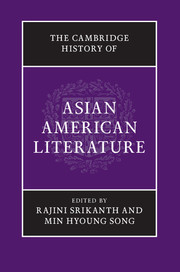Book contents
- The Cambridge History ofAsian American Literature
- The Cambridge History of Asian American Literature
- Copyright page
- Contents
- Notes on Contributors
- Introduction
- Part I Early Forms of Expression to the Start of the Twentieth Century
- Part II The Exclusion Era, World War II, and the Immediate Postwar Era
- Part III The Asian American Movement
- Part IV Canons
- Part V Post-1965 and the Twenty-First Century
- Part VI Twenty-First Century: 9/11, Empire, and Other Challenges to Literature
- 29 The 9/11 of Our Imaginations: Islam, the Figure of the Muslim, and the Failed Liberalism of the Racial Present
- 30 Narrating War: Arab and Muslim American Aesthetics
- 31 Thick Time and Space: Karen Tei Yamashita’s Aesthetics
- 32 Asian American New Media as Literature for the Digital Age
- 33 Beyond National Literatures: Empire and Amitav Ghosh
- Bibliography
- Index
29 - The 9/11 of Our Imaginations: Islam, the Figure of the Muslim, and the Failed Liberalism of the Racial Present
from Part VI - Twenty-First Century: 9/11, Empire, and Other Challenges to Literature
Published online by Cambridge University Press: 05 December 2015
- The Cambridge History ofAsian American Literature
- The Cambridge History of Asian American Literature
- Copyright page
- Contents
- Notes on Contributors
- Introduction
- Part I Early Forms of Expression to the Start of the Twentieth Century
- Part II The Exclusion Era, World War II, and the Immediate Postwar Era
- Part III The Asian American Movement
- Part IV Canons
- Part V Post-1965 and the Twenty-First Century
- Part VI Twenty-First Century: 9/11, Empire, and Other Challenges to Literature
- 29 The 9/11 of Our Imaginations: Islam, the Figure of the Muslim, and the Failed Liberalism of the Racial Present
- 30 Narrating War: Arab and Muslim American Aesthetics
- 31 Thick Time and Space: Karen Tei Yamashita’s Aesthetics
- 32 Asian American New Media as Literature for the Digital Age
- 33 Beyond National Literatures: Empire and Amitav Ghosh
- Bibliography
- Index
Summary
Keywords
- Type
- Chapter
- Information
- The Cambridge History of Asian American Literature , pp. 503 - 518Publisher: Cambridge University PressPrint publication year: 2015
- 8
- Cited by



